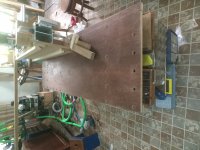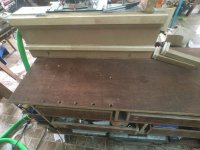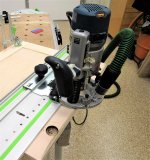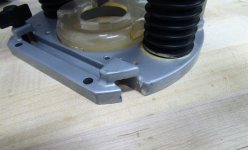gnlman said:
Thanks Dynaglide....funny I'd seen another video where the fellow used a wooden spacer....never thought about the rail being a spacer ..lots of good comments and ideas here on this subject, thanks everyone for chiming in.
Greg
Given that svar's time of 5 minutes per hole is accurate, and Cheese's times of 6 to 8 minutes per hole, more represented the real time, also that you need a level of skill and dedication that is difficult to maintain or achieve for the time needed just for 1 MFT sized top. It is clear that any kind of pattern bit routing is a poor choice needing between 6 and 10 hours for 1 top.
So using a plunge 20mm bit for the holes is the only sensible option.
So having established that there are some options.
1) make your own (say) 30mm hole template full size.
2) make your own (say) 30mm hole template wide but short.
3) buy a 30mm hole template.
4) use the LR 32 directly with no template
5) use the Parf Guide 1 or the new Parf guide 2
Arguments for the above.
1) I did that so am either experienced (or biased you choose). It takes quite a long time to make and needs really close attention to detail. You don't really know if it's perfect or off by a mm or two until after it's made and used (DAMHIKT). If perfect then it is with out question the fastest way to make several (more than 3) tops even if over a long time. It is quite limiting in that smaller tops are not so easy. It avoids any miss alignment of the copy ring problems if you keep the same orientation (not difficult to do)
2) has almost all the advantages above while being more versatile, easier and faster to make, providing fewer opportunities for miss alignment in making. It takes longer than 1) to make a large top and gives its own chances of miss alignment when repositioning.
3) perfect accuracy of holes in the template, small so smaller tops are easily made, if your copy ring is correctly aligned is (without any question at all) the fastest way for larger sized tops if you make less than 4or 5. The problems of copy ring alignment are mentioned in other posts. My jig is in customs now and I have to make a 300 km trip to get it so will report later when I've got it.
4) certainly a reasonable choice if you are only making 1 and you have ( or want an excuse to get) an LR32. There is no alignment (centring of the bit) issue, you have to be really careful as a mistake will make any time saving over a template irrelevant as you will need to remake the complete top
5) (versions 1 & 2 are functionally the same.) Advantages: for any size of top you can decide at any time that you need 20mm holes in any of the grid positions, your only requirement is that you drill the 3mm holes for the complete grid first if you want to position 20mm holes perfectly anywhere anytime. (For example You could make a cutting station for the 5 meter rail in less than 20 minutes. No other system comes close to doing that, if they can do it at all.) The option to just drill the 3mm grid and add 20mm holes later is amazingly versatile and makes using surfaces never designed for the 20mm grid an option you can use after designs and made. You can make 20mm x 96mm grids on different patterns permitting some unusual clamping and cutting options.
Disadvantages: if you need a large size complete grid it is slow, much faster than a pattern bit, much slower than a template. The repositioning of the guide takes more time than you think it will.
The Parf guide IMNSHO shines in making a smaller number of (perfectly aligned to the grid) holes that can be widely separated, adding holes to surfaces you didn't think of originally, making a single row in a narrow board.
My opinion:
I made the big jig and would not have done so if I knew then what I know now, it was good practice and education.
I have the Parf Guide 1 and am finding new uses for it, it is as accurate as suggested, not much skill needed (but certainly imagination). An incidental benefit is 2x1 meter straight edges
I need some complete grid surfaces so have The Dominofix MFT jig on the way in customs now so will update later






